How the classical planets rule the zodiac signs.
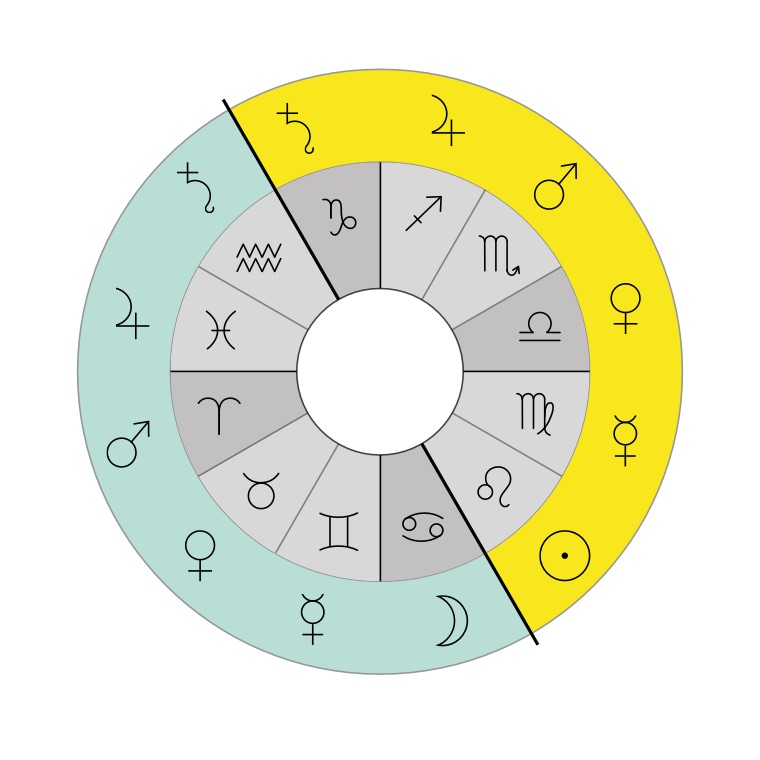
The seven classical planets — the Sun, the Moon, Mercury, Venus, Mars, Jupiter and Saturn — and their relationship to the signs of the zodiac present a surprisingly beautifully sophisticated model.
Humans tend to know and comprehend the objects that we can see with our eyes much better that something we only heard of and never touched with our senses. The planets are no exception. Pretty much everyone has seen the seven classical planets in the sky — the Sun, the Moon, Mercury, Venus, Mars, Jupiter and Saturn — and thus established an instinctive understanding and relationship with those bodies.
Not so with the trans-Saturnian planets — Uranus, Neptune, Pluto, Eris, etc — that are out of our direct experience. Yes, we know they exist but they remain completely out of touch for our senses.
If, for just a while, we forget the trans-Saturnian planets and look into the core of the zodiac at its historical roots then a beautifully sophisticated archetypal model emerges. A true wonder in its own right!
Everything is either light or darkness
Light and darkness are the two fundamental principles that uphold the dualism of the universe. Light symbolises creative-active “masculine” principle. Darkness symbolises creative-passive “feminine” principle.
Light creates the day and its diurnal manifestations. Darkness manifests the night and its nocturnal properties.
The circle of the tropical zodiac signs begins with Aries that traditionally marks be arrival of the spring in the northern hemisphere and thus described as a diurnal and masculine principle.
Other signs follow in an alternating order: Taurus is nocturnal and feminine, Gemini is diurnal and masculine, and so on.
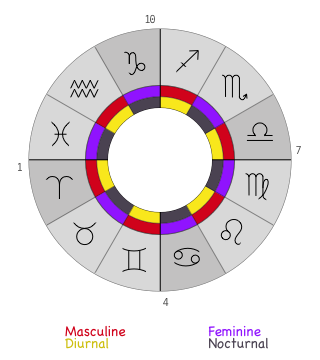
Where is the Earth located in astral spaces?
In the traditional esoteric model, the Earth is “wrapped” by several layers of planetary spheres, pretty much like a matryoshka doll. The closest sphere is the one of the Moon, the most distant is the sphere of Saturn.
To certain extent, the order of the planetary spheres matches the order of planets yet with some exceptions. It’s important to keep in mind that the planetary spheres are understood more like principles rather than concrete physical bodies. A physical body manifests and reflects the principle and is never a perfect and logical copy of it.
The seven planetary spheres follow this order, as illustrated below:
7. Saturn ➝ 6. Jupiter ➝ 5. Mars ➝ 4. Sun ➝ 3. Venus ➝ 2. Mercury ➝ 1. Moon ➝ Earth

Mapping planets to the zodiac signs
Now that we are equipped with the notion of day/night, masculine/feminine and planetary spheres, let’s look at the seasonal unfoldment of the tropical zodiac.
The Sun entering the tropical sign of Cancer marks the beginning of summer (the 22nd of June) when the warmth arrives. Then follows the tropical sign of Leo (the 23rd of July) with its heat.
The two signs are ruled by the two luminaries:
- the Sun and its heat mapped as the ruler of Leo
- the Moon and its warmth mapped as the ruler of Cancer
The zodiac circle is conveniently split into two semi-circles:
- lunar and feminine
- solar and masculine
Each semi-circle acts as a domain for either diurnal or nocturnal polarity. Consequently, a planet can express itself in a two-fold manner depending on the semi-circle. For example, there are can be two manifestations of Saturn: one for the day and another for the night. This idea certainly makes sense!
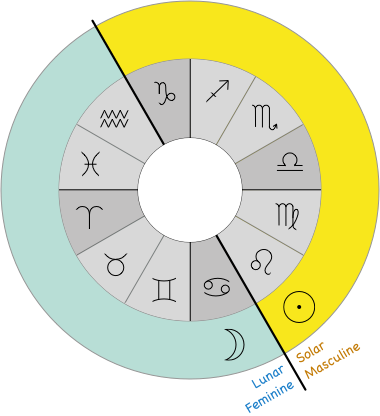
Now, beginning with Saturn which is the most distant and cold body in both planetary spheres and the classical planets. Saturn becomes the ruler of the opposite (with respect to the solar-lunar dividing line) pair of signs — Aquarius and Capricorn.
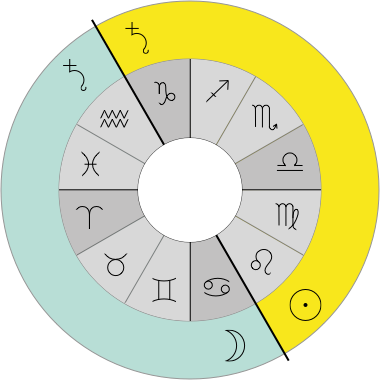
Next, following the order of planetary spheres, the rest of planets can be allocated as the zodiac rulers:
- Jupiter rules Sagittarius and Pisces
- Mars rules Aries and Scorpio
- Venus rules Taurus and Libra
- Mercury rules Gemini and Virgo
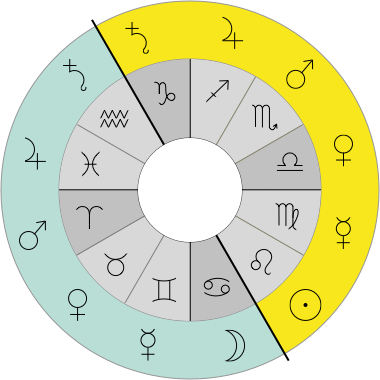
Some interesting observations follow:
Mercury is never further than one sign distance (maximum elongation is between 18° and 28°) from the Sun and its position makes sense.
Venus maximum elongation is between 45° and 47° (never larger than two signs) and thus Venus rules the second sign away from the Sun.
The order of qualities of the planets nicely alternates:
- Saturn is cold and anaemic
- Jupiter is favourable
- Mars is dry
- Venus is favourable
In other words, Saturn and Mars are life-contracting principles while Jupiter and Venus are life-expanding principles.
Back to the trans-Saturnian planets
Uranus, Neptune, Pluto and recently discovered Eris can be seen as higher octave add-ons to the classical planets. The following correspondences can be observed:
| Planet | Higher octave of | Secondary ruler of |
|---|---|---|
| Uranus | Saturn* | Aquarius |
| Neptune | Jupiter** | Pisces |
| Pluto | Mars | Scorpio |
| Eris*** | Venus | Libra |
* Uranus also strongly relates to Mercury due to its electric and fast moving qualities. Uranus is a tricky case and as all trans-Saturnian planets are not easily constrained to a well-defined box.
** Neptune can also be seen as a higher octave of the Moon. Yet its universal expansiveness also fits the airy expansiveness of Jupiter.
*** It should be noted that Eris astrological profile fits the mythological Persephone but unfortunately that name has already be taken by an asteroid. In terms of its energies, Eris/Persephone can be seen as a female correspondence of Pluto.
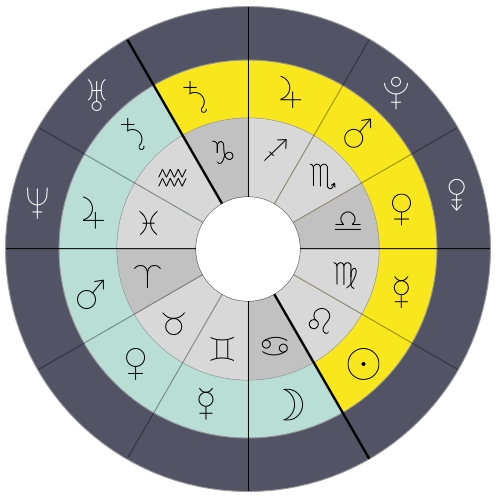
Which sign gives a planet more power?
The model above fits the day/night duality really well as each planet has both diurnal and nocturnal manifestations. It makes sense to recognise the power of the planet with respect to the modality of the sign it is in. Day signs give the planet more manifesting power (think the Sun’s direct light), night signs give more reflective and subdued power (think the Moon reflecting the Sun’s light).
The general idea is that the planet is stronger in its day sign.
| Planet | Day sign | Night sign |
|---|---|---|
| Saturn | Aquarius | Capricorn |
| Jupiter | Sagittarius | Pisces |
| Mars | Aries | Scorpio |
| Venus* | Taurus | Libra |
| Mercury | Gemini | Virgo |
* An inquisitive reader will no doubt notice that Venus rules over Taurus that is a night sign. How come Venus is stronger in Taurus? A few explanations are possible here. The first quadrant of the Zodiac is experientially stronger since it symbolises the first three months after the Vernal Equinox — spring and very beginning of summer — the time when the energy springs forward. The second observation is that Venus is not exactly like all other planets, Venus spins in a different direction! This may give us a hint to treat Venus differently. And finally, centuries of astrological observations and analysis point at Venus being stronger in Taurus than in Libra, the sign most associated with the symbolism autumn.
This story followed the interpretations given by Ptolemy who is regarded as the originator of the modern Western astrological thought.
Zodiac’s sophistication
The zodiac is truly an elegant invention, and we hope that the reader has enjoyed this archetypal tour into the deep knowledge devised by the humankind many centuries ago without any help from computers and with a lot of help from inquisitive and observing minds.
10 Comments
Tony
btw, shouldn’t Saturn day sign be Capricorn instead of Aquarius according to your interpretation. Tq
Time Nomad
This table is actually based on the alternating diurnal/nocturnal distribution of signs where Aries is considered diurnal, Taurus nocturnal, Gemini diurnal, etc. Then it all falls into order… until Venus that should have Libra as its day sign but traditionally considered to have Taurus as the day sign. This sort of makes sense experientially. Plus Venus spins in opposite direction to other planets. Anyway, go figure!
Michael
If Aries is considered masculine and diurnal, why does it appear to be associated with the side of the moon and given the color aqua in your chart?
Time Nomad
I would call it the principle of “dominant polarity”.
A circle (the unmanifested unity) through the power of manifestation becomes divided and produces a state of duality (day/night, masculine/feminine, left/right, white/black, etc.). This would mean that the circle now has two halves with each of them broadly ruling over some dominant polarity. At the same time, no half is an island, it still encompasses both polarities from within. It’s quite like fractals, you can zoom into them endlessly — movement from broader to deeper preserves the original design.
Every woman has a degree of masculinity inside, and every man has a feminine side. The separation of sexes doesn’t draw a hard boundary. Similar with the seasons and the whole of the Zodiac circle. It’s a fascinating topic you’re touching!
Confused
The table at the end makes me confused because in traditional astrology, from what I’ve read, it depends on the planetary sect. I read “A Practical Guide to Traditional Astrology” by Robert Crane and he said that diurnal planets tend to ‘prefer’ their diurnal signs (So, Jupiter prefers Sagittarius, Saturn prefers Capricorn) and that nocturnal planets ‘prefer’ nocturnal signs (Mars for Scorpio, Venus for Taurus). Why did you [or others] discard this idea?
Confused
(Oops, I meant Joseph Crane for the book, LOL)
Time Nomad
Taking your good comment into consideration I have updated that part of the article with the goal to further explain why the planets were assigned this way. I have also specified that this article has been written in accordance with the teachings of Ptolemy who lived approximately in years AD 100–170 and considered to be the father of the Western astrological thought.
There are certainly other plausible versions and explanations, for example the one that you are referring to, originated by Joseph Crane who is a modern author. It’s really a matter of preference as there are no really hard lines in astrology. Time Nomad blog is based on the classical astrological works that are often centuries old and passed the period of hot debates and a certain equilibrium of consensus has been reached.
Lucy Moore
The binary of light and dark is built into the natural design of the universe-the values assigned to them are cultural constructs. In patriarchy, masculine/physical strength and external activity all associated with light and good and valued more…but there are many cultures that have other values, and indigenous cultures, people who live close to the earth, feminists l, and ecological perspectives tend to see this duality (and the whole spectrum of all the shades and tones in between) as all equally valued parts of the whole (and of one’s wholeness). It is tedious and so limiting to constantly see this kind of sex-role stereotyping of the universe portrayed as if it is a fixture of nature, which it is not! But aside from this filter …I like your overall summary of the structure of reality based on the map of the zodiac !
Learn basic Geometry or don't speak
You falsely claim that Aquarius and Capricorn are opposites. They are right next to each other. Opposite means 180 degrees. Opposite. The opposite of Capricorn is Crab. The opposite of Aquarius is Leo. You need to understand basic grade school geometry.
Time Nomad
You have misunderstood the meaning of the opposite in this case. The article is talking about the solar-lunar (masculine-feminine) dividing line that is clearly shown in the illustration. Aquarius and Capricorn are indeed on the opposite sides of that line.